Content
- 1 Bird breeding principles
- 2 Growing young livestock: features
- 3 How to feed the young?
- 4 How to feed the birds properly?
- 5 Interesting Facts
- 6 Economic aspects of quail breeding
- 7 Quail keeping conditions at home for beginners
- 8 How to breed quail?
- 9 Arrangement of cages for quails
- 10 Keeping adult quails
- 11 Benefits of quail breeding
- 12 Breed selection
- 13 What to look for when buying?
- 14 Conditions of detention
- 15 Breeding offspring
- 16 Bird feeding
.
Quail is an excellent choice for a poultry farmer looking for meat and dietary eggs. The miniature size and unpretentiousness of this bird make raising quails in a private backyard or even in an apartment affordable for both experienced poultry breeders and for beginners from scratch. Breeding does not require special conditions or material costs, it is characterized by productivity and promising as a business.
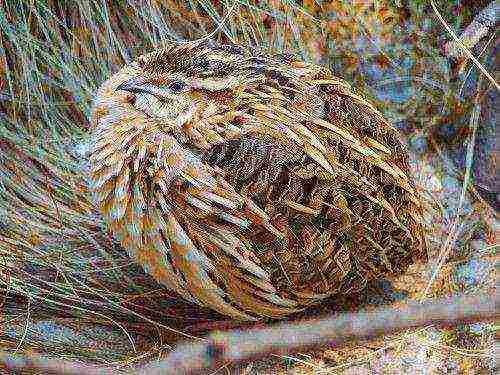
Quail breeding is a profitable business
Characteristic
In the wild in our country, there are European and Japanese subspecies. The latter was domesticated and made an object of quail breeding in Japan, where this tradition goes back several centuries. Now the descendants of the Japanese version are raised for meat or for obtaining egg products in small farms and industrial enterprises.
Breeders brought out representatives of the egg and meat directions. A domesticated variety that is grown for eggs is characterized by the following characteristics:
- quail weight - up to 130 g, females - up to 150 g;
- the beginning of oviposition - from the age of one and a half months;
- productivity - up to 340 pieces weighing 10-12 g annually.
Breeding of broilers has spread in the world to get tasty dietary quail meat. Representatives of this trend weigh from 250 to 500 g.

Broiler quail
Breeds
Quails are grown for egg, meat and meat-egg production. Many breeds allow you to choose the right herd in accordance with the main product received:
| Breed | Direction | Color | Weight, g | Egg production,% | Egg product weight, g |
| Japanese | Egg | Yellow brown | 130 (males); 150 (females) | 90 and above | 9-11 |
| Manchurian | Meat and egg | Yellow brown | Up to 300 | 85 | 13-16 |
| English white | Meat and egg | White | 280-350 | Over 85 | 13-15 |
| Pharaoh | Meat | Yellow-brown with stripes | 320-360 (female); Up to 280 (male) | 85 | 12-16 |
| Phoenix | Meat and egg | Yellow-golden | 250 | Over 85 | 12-18 |
| Texas white | Meat | White with black spot | Up to 500 | Up to 85 | 14-16 |
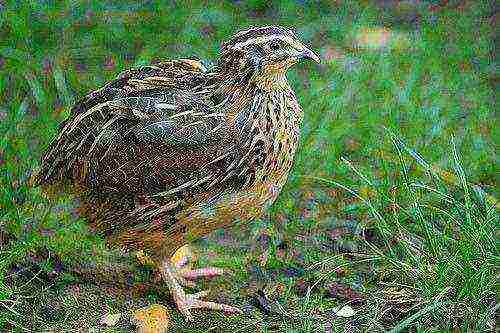
Pharaoh quail
Productivity
Quails have an intense metabolism and high productivity. A quail weighing 120 g lays more than 300 eggs annually, and the egg mass is 20-24 times greater than the female's weight. They are superior in nutritional value to chicken, they do not contain cholesterol. They are also used raw, since quails do not suffer from salmonellosis. Five pieces of quail, equal in weight to chicken, surpass it in content:
- potassium (five times);
- iron (four and a half times);
- vitamins B1, B2, A;
- phosphorus, cobalt, nicotinic acid;
- protein (60% versus 55.8% in chicken), antioxidants.
The color of the shell is from dark variegated to white, the shell is fragile and accounts for 7.2% of the total weight (in other domestic species - 10%). With the help of this product, a number of diseases (internal organs, skin) are treated, the effects of radiation are removed from the body.It does not cause an allergic reaction, on the contrary, the ovomucoid contained there suppresses it. Recommended dosage: for an adult - from 4 to 6 pieces, for a child - from 2 to 3 daily.
Meat is characterized as dietary, it has a high content of vitamin B, minerals, amino acids.
It does not deteriorate and does not lose useful qualities from long-term storage. Recommended for disorders of the gastrointestinal tract, cardiovascular system, diabetes and other diseases.
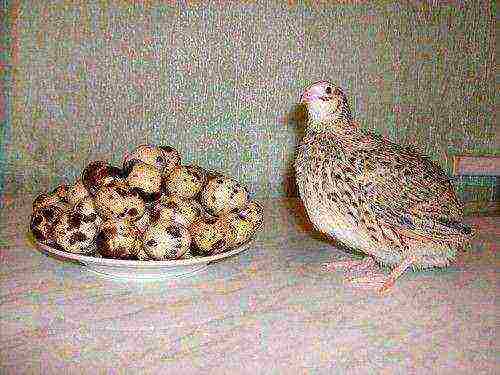
Quail eggs are a valuable dietary product
Reproduction
Quails rush without a male. But if your goal is breeding, then you will need representatives of both sexes. For this, it is better to buy young animals (age - a month or a half). Young quails more easily endure the stress of travel and a new place of residence. When purchasing a livestock, carefully examine it. In healthy specimens:
- clean plumage around the cloaca;
- average weight (not emaciated or overfed);
- dry, no deformation beak;
- breath clear in sound;
- smooth, clean feathers with no dirt or excrement fragments.
For breeding, choose females 3-8 months old, male quails -3-6. Cross specimens of the same breed, avoid closely related mating.
Quails in the process of selection have lost the instinct of brood hens. Use incubators for breeding from scratch and obtaining young stock.
Better use models in which the eggs turn over automatically or semi-automatically. Eggs for hatching chicks are selected from females 2-10 months old, fertilized, no older than a week, weighing 9-11 g.
You can assemble an incubator with your own hands (when keeping and breeding in an apartment):
- place a soft mat in a cardboard box;
- install a medical thermometer;
- fix the 40 watt lamp on top;
- adjusting its height, achieve a temperature of 37.5-38.5 degrees;
- put a saucer of water next to it (to maintain humidity);
- put the net on the bottom;
- Spread no more than 20 eggs of the same size on the bedding and turn them 3-5 times during the day.
The young will hatch in 17 days. They appear at the same time, within five or six hours.
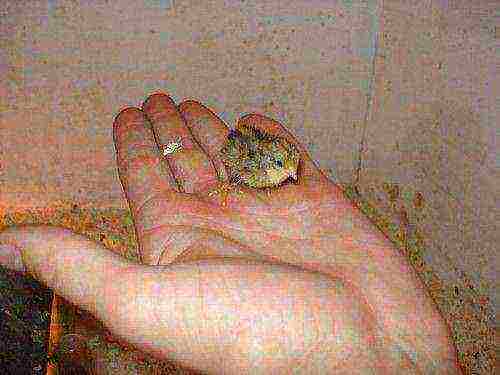
Quail chicken
Offspring
Chicks weigh 6-8 g, they are active from the first hours of life. They are covered with brown fluff, on the back there are two light stripes. If you do not keep track of them, then the young are clogged in the cracks and suffocate, drowning in a saucer of water. Be vigilant and, when the chicks are dry, transplant them into a brooder - a room covered with a mesh net that will fit in an apartment. The size of a brooder is determined by the number of healthy quails.
The overall technology of quail keeping is simple. They feed on their own. Make them a protein diet. In the early days, serve finely chopped boiled white and yolk 5 times a day. From the third or fourth day, add cottage cheese, a combined feed for chickens (type "Start", after processing in a coffee grinder). On the seventh day, give chopped greens. On days 21-28, feed like adult quails.
Chicks with intensive, balanced nutrition gain 20 times their weight during the first two months. For watering, use a vacuum or nipple drinker to prevent the young from drowning. Give water boiled, warm. For prevention, give the quail chloramphenicol in solution to drink.
In the first 14 days, apply lighting in the brooder for 24 hours, then reduce to 17. Young animals need a dry and warm (35-38 degrees) room with ventilation.
If the chicks are cold, then they huddle and squeak (in this case, lower the lamp below). If they stand around the perimeter with their beaks open, raise the heat source. After a week, reduce the heating to 34 degrees, after 2 - to 30 and by the end of the fourth week set it to 22.

40 day old quails are ready to breed
After 21 days, the quails show external signs of sex.Males acquire a red-brown speckled coloration of the neck and chest; in females, these places are light gray speckled. At 8 weeks of age, young males stop growing, by the 40th day they are ready to reproduce. Males not intended for breeding and rejected females are placed in separate rooms for fattening. In females, the maturation process lasts longer (up to 9 weeks).
Care
Quails are kept in cages, aviaries. Some breeders even choose equipment from cardboard boxes. Birds need an area of 30 by 30 cm (20 to 25 cm high) with 1 male and 3-4 females. With a large room and the previous number of quails, the productivity of the family decreases.
If the height is more than 25 cm, then cover the ceiling with soft material so that the inhabitants of the cage do not break their heads during takeoff. When kept in an aviary with a high ceiling (1.5 m), they do not reach the top.
On an industrial scale, in enclosures for 700 heads, there are up to 20 square meters of area. Cage complexes (multi-tiered batteries), which can accommodate 250 animals, are also used for keeping. The complex consists of several cages with drinkers, feeders and egg collectors. It is easy to make such a structure yourself from plywood, wire mesh and metal sheets.
Quails do not need nests or perches. They lay eggs on the floor. Place the flooring there: straw, shavings, paper, hay. Keep the litter clean, change it regularly to fresh one. Daylight hours for the quail family are no more than 20 hours with a dim source. With illumination for less than 17 hours, productivity decreases, more than 20 - the inhabitants of the cages show aggression, and this leads to the death of the livestock. In poultry farms, daylight hours lasts 18 hours (then three times alternation of 2 hours of darkness and light).
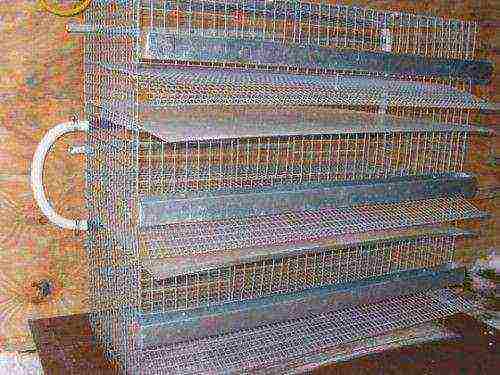
Quail cage
When equipping a cage or aviary, take care of ventilation, but without drafts (otherwise feathers will begin to fall out). Keeping quails requires a dry, warm room with a temperature of 20-22 degrees (fluctuations down to 16 are allowed, up to 25). When breeding in an apartment, it is easy to provide such indicators. If the thermometer drops below 16 degrees, egg-laying will stop. At a temperature of 5 or less, the livestock will die.
Humidity in the quail room is 60-70%. Make sure that this indicator is not less than 55 and more than 75%. To maintain the humidity level, spray the air with water from a spray bottle or water the floor (in winter). Install trays of ash around the perimeter so that the quails arrange dust procedures and get rid of insects in their feathers, and a tray for excrement.
Clean the floor and remove the droppings daily, which is especially important when keeping in an apartment. Perform a full cleaning on both young and adult specimens once a week.
The diet
When equipping feeding and watering places, use portable containers. Feeders and trough-type drinkers are placed outside the perimeter of the cage, and its inhabitants protrude their heads to quench their hunger or thirst. This measure keeps the room clean. Feed the quails 2-3 times a day, allocating 25-30 g of food per head. Do not overfeed the quail family, this decreases egg production.
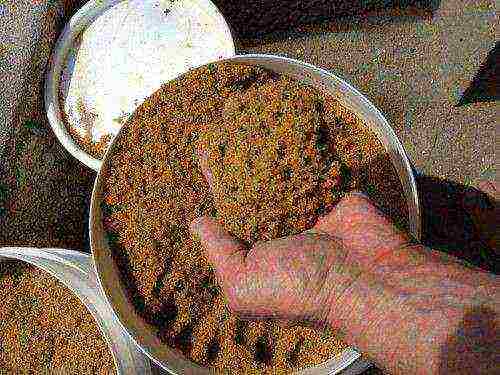
Quail food
Include in the diet of birds:
- chicken feed;
- cereals (oats, barley, millet);
- greens (wheat germ, onions, lettuce and clover);
- vegetable peelings (boiled or raw potatoes, cabbage, carrots);
- sunflower seeds, cottage cheese, sliced eggs;
- fishmeal, chopped raw or boiled fish;
- crushed chalk, crushed eggshells, shell fragments (2-3 times a week);
- fish fat.
When keeping in a private backyard, release pets to the area where they eat slugs and snails. Watch the temperature outside - at least 18 degrees (birds do not like sudden changes).If you breed quail in an apartment, then give them live insects, which are sold in pet stores.
When feeding, avoid offering greens such as tomato, potato, parsley, celery. Solanaceous and buttercup plants, buckwheat, rye cause indigestion and poisoning.
Monitor the color and consistency of the quail droppings. A healthy bird has dense, dark excrement with white streaks. If the droppings are liquid and dark green, this is a sign of illness. A yellow bowel movement indicates an excess of carbohydrate. If the flock has diarrhea, give the oat or rice tincture together with water.
Make sure that the quail family has boiled, warm water. Keep it clean, fresh, change it regularly. Use trough, microcup, or nipple drinkers. Wash the gutter containers daily.
Health
Watch for behavioral changes in the quail family. If the bird is not eating, passive and inactive, isolate it from others and see your veterinarian. After physical injury (pecking due to bright light, lack of space), send the quail to a separate cage until recovery occurs. Females often die from damage to the oviduct due to too intensive clutching. Reduce the level of protein in the feed, shorten the daylight hours.
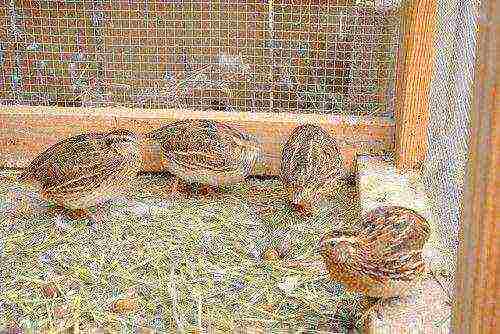
The health of quails must be carefully monitored.
Fattening and slaughter
Quails intended for meat are divided according to gender. Young males and females are kept separately. The lighting and temperatures are reduced. Heating the cage - up to 24 degrees. It is better to dim the light by creating twilight. In such conditions, males do not conflict, mobility decreases, and food consumption increases. Eating 3-4 times a day. The quails are fed with herbs, grain with a 5% addition of fodder fat.
Broiler males are sent for meat by the end of the second month of life. Females are slaughtered by the end of the first year, after intensive egg-laying has been completed. Before the trial, the birds are not allowed to eat and are given plenty of water.
When slaughtering with a sharp knife blade or a kitchen hatchet, the head is cut off. Let the blood drain, cut off the legs at the level of the lower leg and wings to the second joint with scissors. Hold the carcass with its belly up, tear the skin with your thumbs and remove it along with the plumage. Gut the quail with a knife or finger.
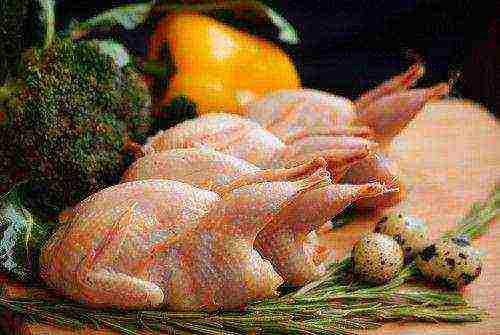
Quail carcasses must be thoroughly cleaned
Additional Information
- birds are also used as fighting birds; in some areas quail singing is valued;
- in Japan, their breeding spread after the bombings in Hirashima and Nogasaki (eggs were included in the school menu to suppress the symptoms of radiation);
- if the birds are fighting, place the instigator of conflicts in another cage or separate him from the flock with a partition;
- quails do not tolerate stress well - take care of the absence of irritants;
- Do not place paper or newspapers on the brooder floor to prevent the chicks' legs from moving apart.
Growing quails at home, subject to the rules of care and feeding, will bring the expected result. They are suitable for meat, egg production or decorative breeding. Given the unpretentiousness, rapid growth and low feed consumption, quail farming will become a profitable business.
Subscribe Be aware of new products on our site
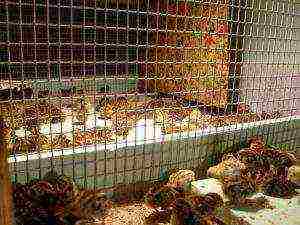 Many people are beginning to think about how to grow quail at home, given the value of dietary meat, eggs of this type of bird. Such food is incredibly healthy, rich in valuable substances and microelements. Birds rush almost every day, so if you keep only a hundred individuals, you can provide your family with a high-quality, natural product. Quail meat is much more expensive, it is considered healthier than chicken.
Many people are beginning to think about how to grow quail at home, given the value of dietary meat, eggs of this type of bird. Such food is incredibly healthy, rich in valuable substances and microelements. Birds rush almost every day, so if you keep only a hundred individuals, you can provide your family with a high-quality, natural product. Quail meat is much more expensive, it is considered healthier than chicken.
Bird breeding principles
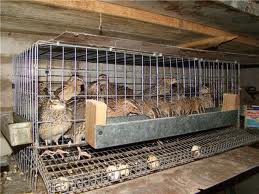 Small birds are bred almost everywhere: in the country, in an apartment, balcony, garage. The main thing is to meet the conditions, temperature conditions.Birds do not need special walking, there is no need to build a chicken coop, a separate building. Today, 50 individuals can easily be housed in a cage of no more than one square meter.
Small birds are bred almost everywhere: in the country, in an apartment, balcony, garage. The main thing is to meet the conditions, temperature conditions.Birds do not need special walking, there is no need to build a chicken coop, a separate building. Today, 50 individuals can easily be housed in a cage of no more than one square meter.
With the correct organization of the conditions of detention, a livestock of 50 individuals can replace 8 chickens in terms of the number of eggs laid. A novice poultry farmer, choosing to grow quails at home from scratch, decides in what way it is profitable to acquire a farm - buy birds or use an incubator, independently breed chickens.
How to organize proper conditions of detention?
Taking into account the location of the cage, an optimal temperature regime should be organized. A suitable temperature is from 18 to 20 degrees Celsius, this indicator must be maintained constantly, regardless of the time of day, season and weather outside the window.
Sudden changes in temperature can cause quail disease, a decrease in egg production or the death of livestock.
An important condition is a well-executed cell. A novice poultry breeder must pay great attention to this attribute. Each material of manufacture has its own subtleties, features, performance characteristics.
When choosing (making) a cage, it is necessary to take into account the following rules:
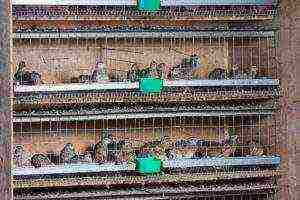 The structure must be made of durable, wear-resistant, reliable materials - metal mesh, plastic, wood.
The structure must be made of durable, wear-resistant, reliable materials - metal mesh, plastic, wood.- The inside should contain 2 trays, be at an angle so that the eggs can roll freely, and the birds do not crush them.
- It is necessary to provide free access for cleaning the droppings to exclude the appearance of infection.
- It should be borne in mind that the height of the cage should be more than 20 cm, so the birds are quite mobile, active.
- The distance from the floor to the beginning of the structure, the pallet should be at least 40 centimeters.
- Large distances should not be allowed between the rods so that the eggs do not fall out, and the birds remain in the cage.
- The most durable material of choice for most breeders is galvanized steel mesh.
 Answering the question of where to start breeding quails, we can safely say - with the correct organization of the place, the creation or acquisition of a cage. It is not recommended to save on this design. By purchasing cages from your hands, you can buy a product in which a sick bird was previously located, therefore, additional disinfection is necessary, processing of the structure with special antiseptic substances that prevent the growth of bacteria and microorganisms. Choosing the independent manufacture of a structure, you should strictly observe the parameters - width, height and length.
Answering the question of where to start breeding quails, we can safely say - with the correct organization of the place, the creation or acquisition of a cage. It is not recommended to save on this design. By purchasing cages from your hands, you can buy a product in which a sick bird was previously located, therefore, additional disinfection is necessary, processing of the structure with special antiseptic substances that prevent the growth of bacteria and microorganisms. Choosing the independent manufacture of a structure, you should strictly observe the parameters - width, height and length.
Should I buy adults or chicks?
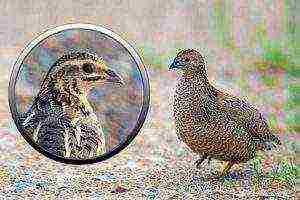 Recently, only a few poultry farmers have chosen to raise quails at home, many are striving to acquire adult birds, or a monthly livestock. Note that the female is able to lay eggs from 1.5 months of age. However, the purchase of birds is always accompanied by risks, so it is better to spend a little effort choosing to raise quails from day 1, having a home incubator.
Recently, only a few poultry farmers have chosen to raise quails at home, many are striving to acquire adult birds, or a monthly livestock. Note that the female is able to lay eggs from 1.5 months of age. However, the purchase of birds is always accompanied by risks, so it is better to spend a little effort choosing to raise quails from day 1, having a home incubator.
Incubation features
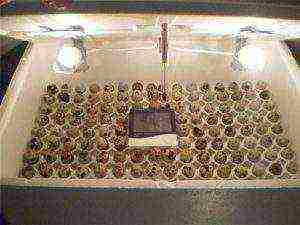 Modern quail cultivation in the country can begin with the acquisition of an incubator. Thus, from one dozen eggs after a certain period of time, with proper care, a real poultry farm grows. Eggs are incubated in the same way as chicken, duck or goose eggs. The only thing is a slight difference in humidity, timing and temperature conditions. Most often, the incubator is designed for 100 eggs. To ensure safety and security, it is enough to place each unit on a small piece of cotton wool, or to wrap the fabric around the edges.
Modern quail cultivation in the country can begin with the acquisition of an incubator. Thus, from one dozen eggs after a certain period of time, with proper care, a real poultry farm grows. Eggs are incubated in the same way as chicken, duck or goose eggs. The only thing is a slight difference in humidity, timing and temperature conditions. Most often, the incubator is designed for 100 eggs. To ensure safety and security, it is enough to place each unit on a small piece of cotton wool, or to wrap the fabric around the edges.
Consider what rules must be followed:
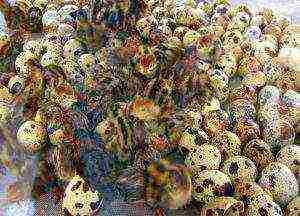 Almost all incubators have a slight temperature deviation, so the contents must be constantly transferred from one place to another.
Almost all incubators have a slight temperature deviation, so the contents must be constantly transferred from one place to another.- When choosing to grow quails, you should buy a product that is no more than seven days old, here freshness is the main selection criterion.
- Chicks emerge from the shell after 16-17 days.
- In a day, the egg should be turned 4-5 times.
- For the first 10 days, it is necessary to maintain the incubator temperature at 38.5 degrees, which can be checked using a special sensor, a thermometer.
- In comparison with chicken chickens, quails are born together, maximum - in 12 hours all will hatch.
Before hatching for one day, the temperature must be reduced by one degree. Quails that are born later, as a rule, have deviations, they are weaker, lagging behind their counterparts.
Growing young livestock: features
For most beginners, the question of how to grow quail is still relevant. This process takes much less time and hassle when compared to chickens. From the first days of life, young chicks need to create optimal conditions. In advance, you need to prepare a brooder, which is easily made from wooden or cardboard boxes, and pull the net on top. Note, quail diseases - symptoms and their treatment, which are given below, can seriously affect the health of young animals:
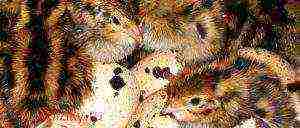 The first sign of poor health is loss of appetite, head tipping back.
The first sign of poor health is loss of appetite, head tipping back.- Grown up chickens can stretch their necks, lower their wings.
- Disheveledness, an unnatural state - these are the first signals for anxiety.
A well-balanced diet helps to avoid infectious diseases; chickens must be provided with vitamins A, D2, and the content of fish meal, meat and bone meal, and yeast must be increased. 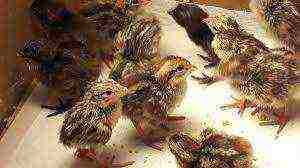 A good addition would be crushed chalk, shell rock.
A good addition would be crushed chalk, shell rock.
Poultry farmers with little experience are sometimes interested in whether quail is sick with salmonellosis, let's answer this question: for a long time it was believed that no, given the high body temperature. However, studies have shown that diseases caused by salmonella - pullorosis, have been identified in some individuals, but this is not dangerous for the human body.
How to feed the young?
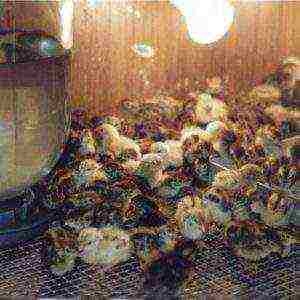 The most complete technology for breeding and rearing quail involves an explanation of how to feed young birds. Initially, you should purchase feeders, drinkers, and other containers with low edges. Drinking bowls are of particular importance. To avoid infection, the spread of bacteria, vacuum models should be chosen. Large containers can allow small chicks to drown.
The most complete technology for breeding and rearing quail involves an explanation of how to feed young birds. Initially, you should purchase feeders, drinkers, and other containers with low edges. Drinking bowls are of particular importance. To avoid infection, the spread of bacteria, vacuum models should be chosen. Large containers can allow small chicks to drown.
The first feeding is a hard-boiled egg, then you can choose the usual compound feed, which is fed to chickens. Chicks grow very quickly, so you need to take care of a comfortable, spacious cage in a timely manner. 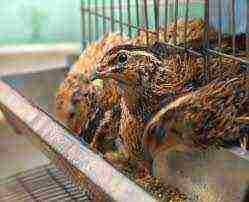 To ensure the optimal temperature regime, the cells can be upholstered with wooden, polycarbonate sheets, while maintaining special openings for air circulation and ventilation. Outside, heating devices are installed to ensure the required temperature.
To ensure the optimal temperature regime, the cells can be upholstered with wooden, polycarbonate sheets, while maintaining special openings for air circulation and ventilation. Outside, heating devices are installed to ensure the required temperature.
Considering the cultivation of quails at home for beginners, lighting and temperature conditions should be properly organized. A rather insignificant and dim light, too bright a luminous flux will cause irritation, aggression of birds.
How to feed birds properly?
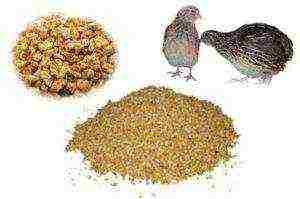 Feeding quail - where to start: note that one bird eats up to 10 kilograms of feed per year, if you calculate the daily rate it turns out - about 30 grams per day. Egg production - 300 pieces per year. Not only the health of the birds, but also the egg production will depend on proper, balanced nutrition. It is advisable to buy feed from trusted, factory-made suppliers. Many experienced farmers recommend feeding the birds with starter feed.
Feeding quail - where to start: note that one bird eats up to 10 kilograms of feed per year, if you calculate the daily rate it turns out - about 30 grams per day. Egg production - 300 pieces per year. Not only the health of the birds, but also the egg production will depend on proper, balanced nutrition. It is advisable to buy feed from trusted, factory-made suppliers. Many experienced farmers recommend feeding the birds with starter feed.
Interesting Facts
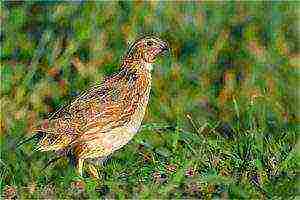 It's no secret where the common quail lives in the wild. The bird lives comfortably near fields, steppes, meadows.Near her dwelling, there are necessarily thickets of grass, weeds, this allows you to provide reliable housing and a varied diet for the chicks. In fact, a small bird has tremendous benefits, it destroys many pests, weed shoots.
It's no secret where the common quail lives in the wild. The bird lives comfortably near fields, steppes, meadows.Near her dwelling, there are necessarily thickets of grass, weeds, this allows you to provide reliable housing and a varied diet for the chicks. In fact, a small bird has tremendous benefits, it destroys many pests, weed shoots.
I wonder how many quails live under natural conditions. According to scientists, a bird can live in the wild for about 5 years, in captivity it is less - only 2-3 years. Although keeping a female for more than 2-3 years is not profitable, egg production drops. The question arises if low temperatures are fatal for birds, where quails winter in nature, the answer is simple - they fly away to warmer regions. Birds are hard to tolerate low temperatures.
What affects reproduction?
Advantageous cultivation and technology of quail breeding, taking into account the specific features, should answer the question of what affects the reproduction of birds. Initially, you need to pay attention to the choice of the age of the livestock when buying. The younger the individual, the easier it will be to endure the change of living conditions, moving, acclimatization. Only healthy birds can reproduce fully.
When choosing birds, you need to consider:
- appearance;
- weight (individuals should not be fat, skinny);
- smooth, dry beak;
- even breathing;
- clean feathers in the area of the cloaca.
For reproduction to be as successful as possible, females are selected - 3-8 months, males - 3-6 months, in a ratio of six females to one male. It is necessary to breed individuals without family ties, in order to avoid hereditary diseases, of the same breed. The incubation instinct in birds is underdeveloped, it follows that the ideal option is to use an incubator.
Healthy appearance
The age of the chick will directly affect the cost of quail for breeding, therefore, in order to save money, you can revel in weekly chicks.
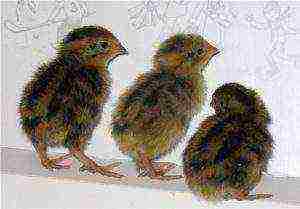 If, after acquisition, specific individuals show symptoms of diseases, any injuries, they should be immediately planted. Some farmers raise birds for meat, then it is necessary to separate females and males into separate cages, it is possible to distinguish the features of the physical structure at the age of one month.
If, after acquisition, specific individuals show symptoms of diseases, any injuries, they should be immediately planted. Some farmers raise birds for meat, then it is necessary to separate females and males into separate cages, it is possible to distinguish the features of the physical structure at the age of one month.
Thus, the main points were considered, answers were found to pressing questions of how to raise quails at home, feed, maintain optimal conditions of detention. Entrepreneurs, ordinary farmers who want to make the transition to a healthy diet, can provide their families with a healthy source of protein food on their own.
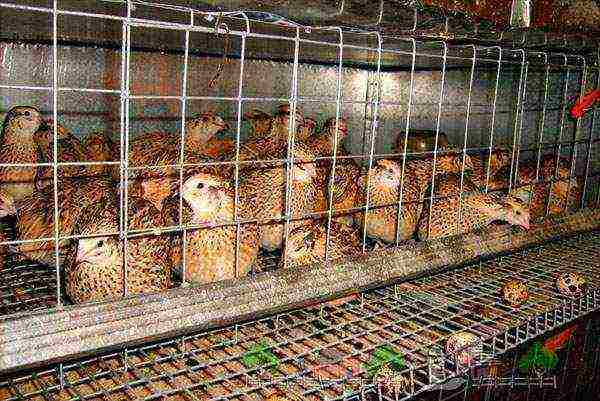 Today, more and more people choose for themselves life in a private house, which involuntarily pushes them to the decision to start keeping livestock useful in the household. The smallest representatives of this vast family are quails. Breeding at home a rather unpretentious bird, responsive to care, is within the power of even beginners.
Today, more and more people choose for themselves life in a private house, which involuntarily pushes them to the decision to start keeping livestock useful in the household. The smallest representatives of this vast family are quails. Breeding at home a rather unpretentious bird, responsive to care, is within the power of even beginners.
Fried, baked with mushrooms and herbs, stuffed quails were served at the tables of the nobility in Medieval Europe and Russia. But if in those ancient times a quail hunt was equipped for several dozen carcasses, today these very small birds are successfully bred both in private farmsteads and in the conditions of large poultry farms.
Economic aspects of quail breeding
Interest in quails among amateur poultry breeders is caused by:
- low costs for the purchase of eggs for incubation;
- ease of keeping poultry;
- quick return on invested forces.
How to start breeding quail at home for novice poultry breeders? What difficulties await them, and what should be considered when creating your miniature farm?
The bird is bred for two purposes:
- for the sake of dietary eggs, nutritional qualities, safety and a number of other indicators that are superior to chicken;
- for obtaining tender low-fat meat.
This should be taken into account when choosing the specialization of the future quail farm and deciding on the breeds for breeding.
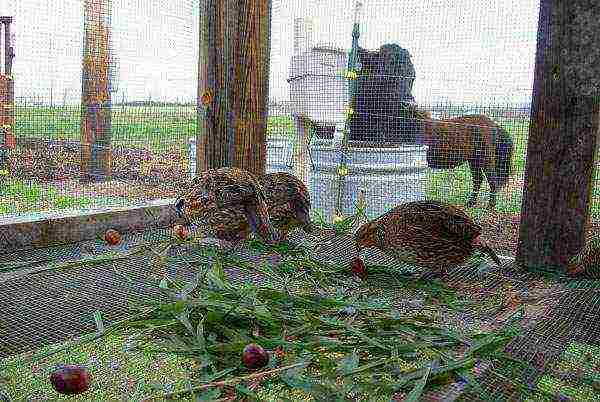 A small herd of quails can fully provide a family with egg products. But is it profitable or not to breed quail as a business? If we compare birds of the meat and egg direction, then the former emit a carcass weight of up to 300 grams with a relatively small, up to 200 pieces, number of eggs. In the second case, the weight does not exceed 200 grams, but from a quail you can get up to 300 eggs weighing about 10-12 grams per year.
A small herd of quails can fully provide a family with egg products. But is it profitable or not to breed quail as a business? If we compare birds of the meat and egg direction, then the former emit a carcass weight of up to 300 grams with a relatively small, up to 200 pieces, number of eggs. In the second case, the weight does not exceed 200 grams, but from a quail you can get up to 300 eggs weighing about 10-12 grams per year.
Within a month and a half after the birth of the quail, they are ready to lay, and only 18 days pass from laying eggs in the incubator to hatching. Such early maturity "never dreamed" of chickens, which directly speaks of the economic feasibility of breeding quails at home.
Quail keeping conditions at home for beginners
If chickens, ducks, geese and other birds are easily mastered in a backyard and can be raised using grazing, then it is extremely difficult to domesticate quails. Therefore, this type of bird is kept in cages.
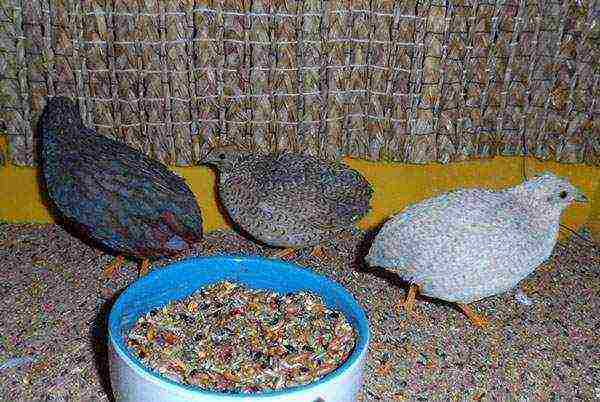 A room for keeping quails in the country is chosen dry, ventilated and warm, but at the same time reliably protected from drafts, which the birds cannot stand. For the active development and maintenance of egg production, birds need lighting. The optimum can be considered a 17-hour daylight hours:
A room for keeping quails in the country is chosen dry, ventilated and warm, but at the same time reliably protected from drafts, which the birds cannot stand. For the active development and maintenance of egg production, birds need lighting. The optimum can be considered a 17-hour daylight hours:
- If the cages are illuminated for longer, the number of eggs will increase at first, but the bird is quickly depleted.
- Short daylight hours, without the use of additional lighting, will not give the desired results from layers and young stock. In the dark, birds are reluctant to feed, which leads to savings in feed, but at the same time inhibits growth.
The unpretentiousness of the bird, the small space occupied by the cells and the quick return of dietary products are the reasons for the popularity of keeping quails in the country, in a private house or even in an apartment.
However, breeding a large number of birds in a residential area is undesirable:
- due to the risk of developing diseases that are dangerous for both birds and humans;
- the difficulty of creating the proper conditions for lighting and ventilation;
- due to an imminent violation of the rules for the use of housing in apartment buildings.
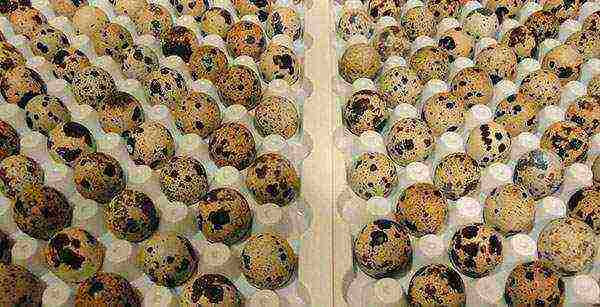 In the country or in his own backyard, a poultry farmer can grow a couple of generations of quails in one summer season and get healthy and tasty eggs from them. The only thing that may cause the need for additional costs is the breeding and maintenance of quails in winter, however, a video about the organization of the process will help to understand the nuances to prevent mistakes even for novice poultry farmers.
In the country or in his own backyard, a poultry farmer can grow a couple of generations of quails in one summer season and get healthy and tasty eggs from them. The only thing that may cause the need for additional costs is the breeding and maintenance of quails in winter, however, a video about the organization of the process will help to understand the nuances to prevent mistakes even for novice poultry farmers.
How to breed quail?
A home quail farm begins with the acquisition of weekly chicks or the incubation of young animals with your own hands. The quails that have appeared require special care and conditions of detention. Before breeding quails, for tiny chicks, they build or acquire a draft-proof cage equipped with lighting and heating.
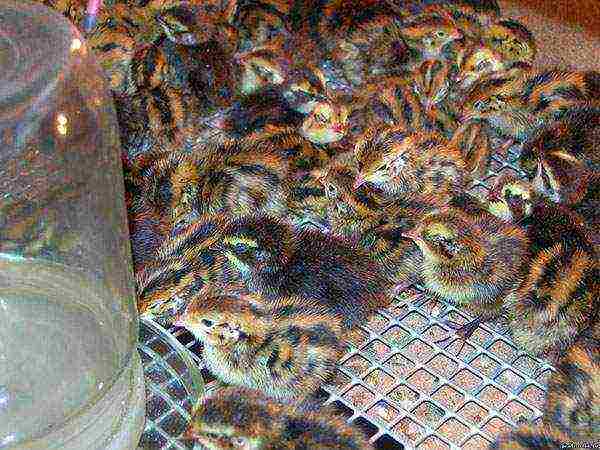 Small quails in the first week of life need to maintain an elevated air temperature at 35–36 ° C. Then the air is gradually cooled in the brooder, bringing it to 30 ° C by the end of the second week. It is important to arrange heating of small quails when breeding at home so that the temperature in the cage changes smoothly, without jumps that threaten the rapid weakening and death of the young.
Small quails in the first week of life need to maintain an elevated air temperature at 35–36 ° C. Then the air is gradually cooled in the brooder, bringing it to 30 ° C by the end of the second week. It is important to arrange heating of small quails when breeding at home so that the temperature in the cage changes smoothly, without jumps that threaten the rapid weakening and death of the young.
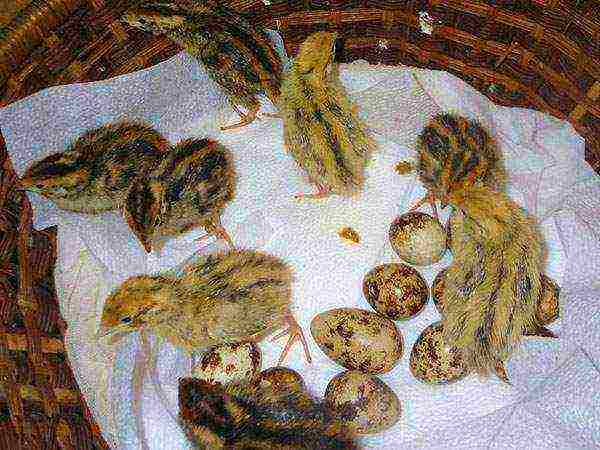 In addition to heat, the quails are left with round-the-clock lighting in the first two weeks. This technique allows you to stimulate the activity of the bird, it often approaches the feeders and develops faster. From 3 weeks of age, the chicks are gradually transferred to 12 hours of light. From 1.5 months, when the quails begin to lay, the birds are placed in cages with a 17-hour daylight hours.
In addition to heat, the quails are left with round-the-clock lighting in the first two weeks. This technique allows you to stimulate the activity of the bird, it often approaches the feeders and develops faster. From 3 weeks of age, the chicks are gradually transferred to 12 hours of light. From 1.5 months, when the quails begin to lay, the birds are placed in cages with a 17-hour daylight hours.
In summer, the birds can be taken out into the air, but there is no open range for quails. And here they are contained in mesh cells.
When keeping quails at home, novice poultry farmers need to pay special attention to the feeding regime and diet, as well as maintaining cleanliness in the cages. To make cleaning less hassle, the cages and baby brooder are equipped with a double bottom and are made of materials that are easy to dry read and wet hygiene procedures.
Arrangement of cages for quails
Convenient drinkers are provided for feeding poultry in places of detention. For young animals, vacuum-type constructions are highly desirable. For adult birds, you can leave the existing equipment or install nipple drinkers that do not give the quails access to the water. As a result, the drinking moisture will always be clean, and the quails themselves will not suffer from hypothermia.
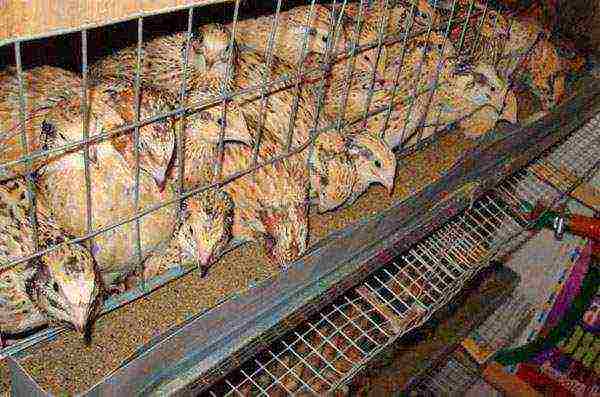 The number of drinkers and feeders for breeding quails at home is calculated based on the number of livestock so that in hot weather or during a mass meal, the pets do not quarrel over food and do not trample the weak. For chicks, tray feeders are installed in the brooder. As they grow older, they are changed to flute structures outside the cells.
The number of drinkers and feeders for breeding quails at home is calculated based on the number of livestock so that in hot weather or during a mass meal, the pets do not quarrel over food and do not trample the weak. For chicks, tray feeders are installed in the brooder. As they grow older, they are changed to flute structures outside the cells.
Keeping adult quails
At three weeks of age, the chicks are placed in adult cages. Females prepare to become layers, and males are sorted for breeding and fattening for meat. At this point, there are changes in the diet.
Protein-rich components are added to quails intended for breeding at home when feeding. This will help future laying hens to increase egg production, and male quails gain weight faster. By one and a half months, young livestock are divided according to gender and parental groups or families are formed, and experienced poultry farmers advise taking a pair of males for eight quails. In this case, the selected individuals are immediately placed in one cage. Subsequently, it is better not to change males, since chickens perceive this very sharply and can even cripple a beginner.
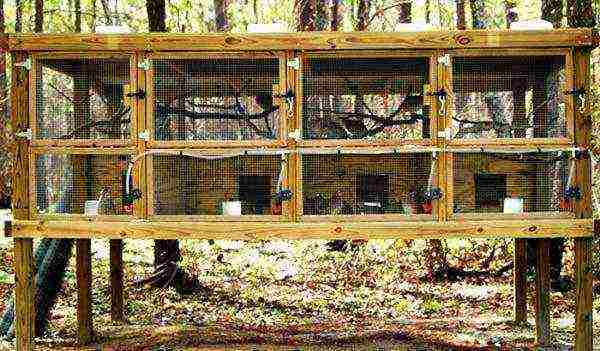 If a group is formed only from layers, then a strong active male can be added to them as needed. In this case, it is easier to control which birds are covered, and egg production is higher with proper supervision.
If a group is formed only from layers, then a strong active male can be added to them as needed. In this case, it is easier to control which birds are covered, and egg production is higher with proper supervision.
Quail breeding and breed selection - video
In the days of Tsarist Russia, quail meat was an integral part of a luxurious table. The birds were specially hunted, sold and bought. Later, quails lost their former popularity, giving way to larger poultry. In the USSR, tiny eggs appeared only in the sixties and were known as the prerogative of expensive restaurants.
Such inattention to the bird can be called unfair. High egg production and ease of care make these birds an extremely suitable species for farming. And the small size allows you not to spend money on building and equipping premises, but to breed birds in your own house or even an apartment.
How to breed quail
Benefits of quail breeding
Perhaps the only drawback of this bird is its compact size. Of course, when compared with chickens and ducks, quails will lose, especially if the purpose of breeding is to obtain meat. However, it is known that when it comes to poultry, their size is inversely proportional to the quality of meat and other important characteristics of life. Representatives of medium-sized species are more resistant to diseases, more often lay eggs, their offspring survive better and adapt to external conditions.
Separately, it is worth noting the properties of quail eggs, according to which the product undoubtedly outperforms chicken eggs. Quail eggs:
- They contain not only the usual protein, but also a whole complex of trace elements that strengthen the immune system and are necessary for a person to maintain health.
- They include more than twice as many vitamins as chicken eggs.
- They improve the condition of bone tissue, have a beneficial effect on the functioning of the kidneys, heart, pancreas, and nervous system.
- They are a dietary product that does not compromise taste.
- They help to improve digestion and are easily absorbed by the body, so they are often recommended for young children.
- Quails do not have salmonellosis, which makes it safe to eat raw eggs.
Quails rush more often than hens
Of course, chicken eggs are larger, but quails are laid more often. You are guaranteed to be able to get one egg a day. Five quails can easily replace one chicken, and given that they are much easier to keep, the difference in size is justified. Some breeders practice artificially extending the daytime to get two eggs per day, but veterinarians do not recommend this method, as violation of the regime negatively affects the health of the birds.
Quail meat also contains a complex of nutrients and is considered dietary. Its great advantage is the preservation of beneficial properties when frozen.
Breed selection
In general, all quails are similar to each other, but depending on the color of feathers and eggs, productive characteristics, size and behavior, they are distinguished into breeds. There are about 34 quail lines in the world, not counting the individual differences within each. However, in our country, no more than ten of them are common.
Quail breeding tips
If you do not breed quail on an industrial scale, but for yourself, it is not necessary to focus on the breed: the difference will be small. But if this is still important, answer for yourself which goal is paramount for you. Quails can be bred for meat, eggs and decorative purposes.
- If your main goal is meat, consider the Pharaoh, Texas White Pharaoh, Golden Phoenix. These are the largest individuals, which are also characterized by rapid growth. The weight of an adult female can exceed 450 grams.
- To obtain the maximum number of eggs, the Japanese quail is recognized as the best breed. Females begin to lay after 40 days and produce more than 300 eggs per year. Also "egg" breeds include English black and marble quail and kitevers.
- Ornamental birds can be chosen according to personal taste. The most beautiful breeds are Californian, Chinese painted, white English quails.
Comparative table of weight and egg production of popular breeds
What to look for when buying?
It is better to buy animals from poultry farms and other places where they are professionally engaged in breeding. This allows you to avoid cheating and receive comprehensive advice on maintenance and care. Be sure to ask what feed the birds ate on farms and follow this diet at least the first time. A sudden change in living conditions will become stressful for the bird, and it may stop rushing.
It is better to buy quails at poultry farms.
Novice breeders are advised to buy several adults, which are much easier to care for. Remember that the hen does not need a male to produce eggs - this is an autonomous process. But if you plan to get new offspring in the future, you will need at least one representative of the stronger sex. The best age for acquisition is 1, 5 months, it is at this age that the female begins to lay eggs. The season when you buy the bird does not matter, since the birds still need to artificially maintain the desired climate.
Monthly quail is the optimal purchase age for inexperienced breeders
Important! When buying, carefully inspect the bird. Tousled feathers, excess dirt on the beak and paws, moisture, and a lethargic and sickly look should alert you. The same goes for the hoarseness and whistle that a quail can make.
Choose birds carefully when buying
Conditions of detention
The small size and unpretentiousness of the birds allow them to be kept almost anywhere - even in a city apartment. However, two important conditions must be met.The first is the presence of cells: quail is still a wild bird. The second is an acceptable temperature. In cold conditions (below 5 ° C), birds fall ill and die, and hot (over 25 ° C) negatively affect the quality of feathers, as well as egg production.
Quail cage
If you keep birds in the country, the place should be heated or equipped with heaters. Also, the room needs to provide good ventilation and a humidity level above 65%. If it is not achieved naturally, containers with water should be placed next to the cages or a spray bottle should be used. In summer, during the day, it is permissible to place cells in the yard. But it is necessary to monitor the absence of drafts and avoid contact with wild birds: quails run the risk of catching various diseases.
Features of a homemade quail cage
Quail cages
In order to save money, a house for birds can be made independently, although professional structures are better equipped. The size of the cells should be selected, remembering that 1 sq. m. should not be more than 6 individuals. The tightness reduces the productivity of birds, however, they also do not like spacious aviaries. Too high ceilings will not work either: attempts to take off can lead to bruises.
Quail cage scheme
Example: in a 30x30x30 square cage, contain three hens and one male. It is recommended to make the floor of the cage slightly inclined - so that the laid eggs accumulate in one place and it is easy to remove them. The entire floor is covered with filler: sawdust, shavings, dry grass. From time to time it is recommended to add ash - for “bathing” for hygienic purposes.
It is contraindicated to frighten birds with loud sounds or sharp flashes of light - they become alarmed and stop rushing.
Feeding adult quails
Four quails eat the same amount of feed as one chicken, but it is much easier to feed them. Food intake should be carried out three times a day according to the schedule (food is better absorbed when it arrives at the same time). The bird is usually quick to manage its portion (about 30 grams per bird).
Feeding quail according to age
Quail feed recipe
It is better to install the feeder and drinker outside the cage, but so that the bird can reach it - for example, by sticking its head through the bars. Thanks to this, the cleanliness of the cells is better maintained. Otherwise, the bird can climb into the feeder, overturn it and interfere with the feed with droppings, which will ensure unnecessary expense.
Feeding errors and their consequences
Quails do not require any exotic dishes - the diet of birds consists of cultures familiar to us. For feeding you can use:
- Special compound feed from factories.
- Shredded cereals.
- Legumes, sunflower seeds, boiled vegetables, green onions.
- Herbs: dandelion, yarrow, cucumber leaves.
- Small insects.
Making a trough feeder
From time to time, you need to add substances containing calcium to the feed: chalk, egg shells. The addition of minced fish has a beneficial effect on the health of birds. Do not give your pets parsley and tops, berries, sorrel, buckwheat.
Breeding offspring
Sexual maturation in quails is early - after 40 days of life. Readiness is evidenced by a soft whistling sound that the female begins to make - this means that soon she will please you with the first egg. However, at first, the carrying will be irregular and the testicular mass is small. After 1-2 months, this process will gradually return to normal.
Homemade quail egg incubator
Note! Domestic quails do not incubate chicks, this instinct is preserved only in wild individuals. Therefore, you will definitely need an incubator for babies.
It is not necessary to use a large incubator: quail eggs are very compact and easily fit into a container.A standard chicken egg device will do, which will have to be slightly modified with cloth and cotton wool. Due to their size, quail testicles warm up faster and better, do not require coups and other tricks.
The eggs of each individual breed, and sometimes within it, are very different in color. The color can be blue, brown, yellow, gray with numerous variable blotches.
Quail eggs can vary in color
Important! Pre-familiarize yourself with what the eggs of your chosen breed should look like, what is acceptable and what is not. If the color obtained is not within the normal range, this indicates that you have made gross mistakes in nutrition and care, and the bird is sick. A greenish tint of an egg always indicates a problem.
To breed healthy chicks, it is imperative to maintain a certain temperature regime in the incubator. Measurements should be taken with a professional thermometer. For the first 10 days, the scale should show 38.5 ° C, and only the day before the withdrawal, the temperature can be lowered to 37.5 ° C. Modern models of incubators include water tanks and allow you to maintain humidity. It is best to cover these connectors with gauze to prevent chicks from falling into the water.
Nursing hatched babies
If you can easily make a cage for adults with your own hands, it is still recommended to purchase a professional brooder to hatch chicks. It takes into account the characteristics of the young and prevents possible problems: for example, slipping of the feet on an unsuitable surface or fright due to the noisy crate lid. Brooders have a slatted floor and allow excretion of droppings from the cage, which has a beneficial effect on the health of the chicks.
Quail brooder
Brooders also provide heating and lighting just as much as the chicks require. If you still maintain the regime on your own, remember that in the first month of the chicks life, the temperature should be gradually lowered from 33-35 ° C to 25. This gradually prepares the brood for an independent adult life. Also, in the first two weeks, the lighting in the cage must be maintained constantly, then the daylight hours must be reduced to 17 hours. It is impossible to reduce it more - this will have a bad effect on the reproductive functions of the offspring in the future.
Homemade brooder for quail
The birds can be separated after three weeks. They can be planted according to gender or depending on the purpose: for fattening, for eggs, etc. The sex of a bird can be determined by the plumage on the breast: males are distinguished by small specks and a darker shade. If possible, it is best not to leave two males in the same cage.
Bird feeding
The conditions for keeping birds intended for slaughter are slightly different from those described. A lower temperature is needed here - 20-24 ° С and dim lighting. Birds need to be fed four times a day, of which two times with grain, and twice with fatty feed mixed with corn.
Quail feeding scheme
When the bird reaches a weight of 120 g, it is already considered ready for slaughter (but depending on the breed, a much higher figure can be achieved). Feeding usually lasts about two months. Birds can only be given water for six hours before slaughter.
The composition of the mixture for quail when feeding
Breeding quails is a guaranteed source of wholesome and healthy food for you and your family, as well as an opportunity for passive income when selling meat and eggs on the market.
Average daily requirement of quail for metabolizable energy and nutrients per head
Video - Features of growing quails


